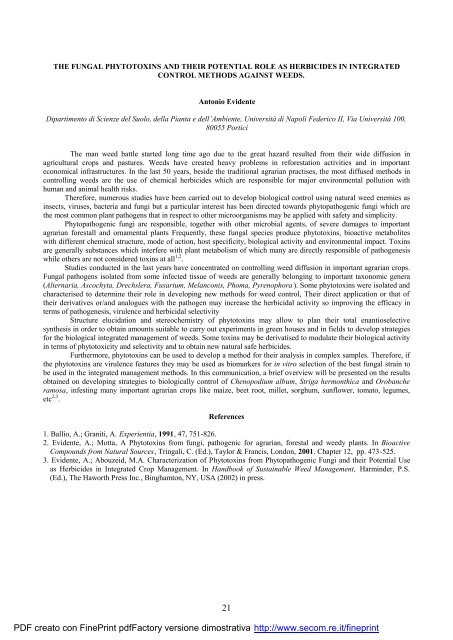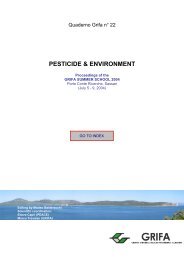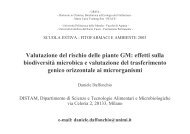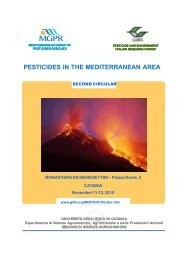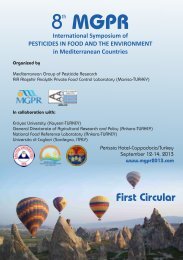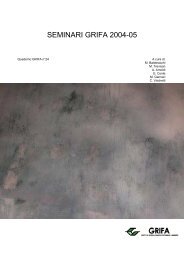International Congress BIOLOGICAL PRODUCTS - Gruppo di ...
International Congress BIOLOGICAL PRODUCTS - Gruppo di ...
International Congress BIOLOGICAL PRODUCTS - Gruppo di ...
Create successful ePaper yourself
Turn your PDF publications into a flip-book with our unique Google optimized e-Paper software.
THE FUNGAL PHYTOTOXINS AND THEIR POTENTIAL ROLE AS HERBICIDES IN INTEGRATED<br />
CONTROL METHODS AGAINST WEEDS.<br />
Antonio Evidente<br />
Dipartimento <strong>di</strong> Scienze del Suolo, della Pianta e dell’Ambiente, Università <strong>di</strong> Napoli Federico II, Via Università 100,<br />
80055 Portici<br />
The man weed battle started long time ago due to the great hazard resulted from their wide <strong>di</strong>ffusion in<br />
agricultural crops and pastures. Weeds have created heavy problems in reforestation activities and in important<br />
economical infrastructures. In the last 50 years, beside the tra<strong>di</strong>tional agrarian practises, the most <strong>di</strong>ffused methods in<br />
controlling weeds are the use of chemical herbicides which are responsible for major environmental pollution with<br />
human and animal health risks.<br />
Therefore, numerous stu<strong>di</strong>es have been carried out to develop biological control using natural weed enemies as<br />
insects, viruses, bacteria and fungi but a particular interest has been <strong>di</strong>rected towards phytopathogenic fungi which are<br />
the most common plant pathogens that in respect to other microorganisms may be applied with safety and simplicity.<br />
Phytopathogenic fungi are responsible, together with other microbial agents, of severe damages to important<br />
agrarian forestall and ornamental plants Frequently, these fungal species produce phytotoxins, bioactive metabolites<br />
with <strong>di</strong>fferent chemical structure, mode of action, host specificity, biological activity and environmental impact. Toxins<br />
are generally substances which interfere with plant metabolism of which many are <strong>di</strong>rectly responsible of pathogenesis<br />
while others are not considered toxins at all 1,2 .<br />
Stu<strong>di</strong>es conducted in the last years have concentrated on controlling weed <strong>di</strong>ffusion in important agrarian crops.<br />
Fungal pathogens isolated from some infected tissue of weeds are generally belonging to important taxonomic genera<br />
(Alternaria, Ascochyta, Drechslera, Fusarium, Melanconis, Phoma, Pyrenophora ). Some phytotoxins were isolated and<br />
characterised to determine their role in developing new methods for weed control, Their <strong>di</strong>rect application or that of<br />
their derivatives or/and analogues with the pathogen may increase the herbicidal activity so improving the efficacy in<br />
terms of pathogenesis, virulence and herbicidal selectivity<br />
Structure elucidation and stereochemistry of phytotoxins may allow to plan their total enantioselective<br />
synthesis in order to obtain amounts suitable to carry out experiments in green houses and in fields to develop strategies<br />
for the biological integrated management of weeds. Some toxins may be derivatised to modulate their biological activity<br />
in terms of phytotoxicity and selectivity and to obtain new natural safe herbicides.<br />
Furthermore, phytotoxins can be used to develop a method for their analysis in complex samples. Therefore, if<br />
the phytotoxins are virulence features they may be used as biomarkers for in vitro selection of the best fungal strain to<br />
be used in the integrated management methods. In this communication, a brief overview will be presented on the results<br />
obtained on developing strategies to biologically control of Chenopo<strong>di</strong>um album, Striga hermonthica and Orobanche<br />
ramosa, infesting many important agrarian crops like maize, beet root, millet, sorghum, sunflower, tomato, legumes,<br />
etc 2,3 .<br />
References<br />
1. Ballio, A.; Graniti, A. Experientia, 1991, 47, 751-826.<br />
2. Evidente, A.; Motta, A Phytotoxins from fungi, pathogenic for agrarian, forestal and weedy plants. In Bioactive<br />
Compounds from Natural Sources, Tringali, C. (Ed.), Taylor & Francis, London, 2001. Chapter 12, pp. 473-525.<br />
3. Evidente, A.; Abouzeid, M.A. Characterization of Phytotoxins from Phytopathogenic Fungi and their Potential Use<br />
as Herbicides in Integrated Crop Management. In Handbook of Sustainable Weed Management, Harminder, P.S.<br />
(Ed.), The Haworth Press Inc., Binghamton, NY, USA (2002) in press.<br />
PDF creato con FinePrint pdfFactory versione <strong>di</strong>mostrativa http://www.secom.re.it/fineprint<br />
21


